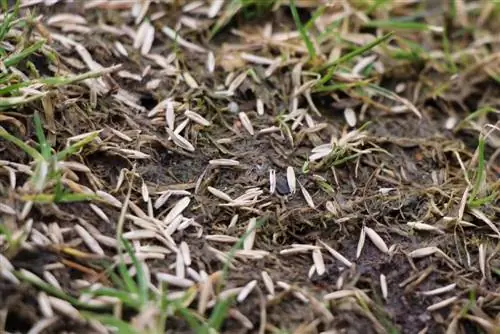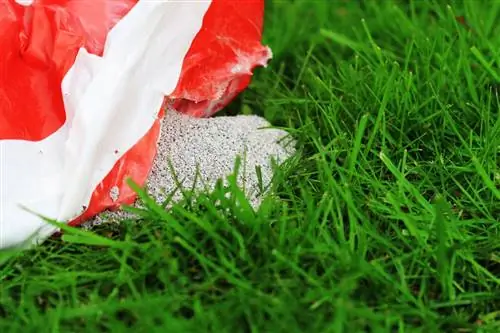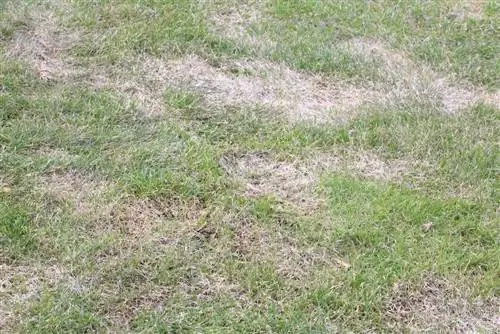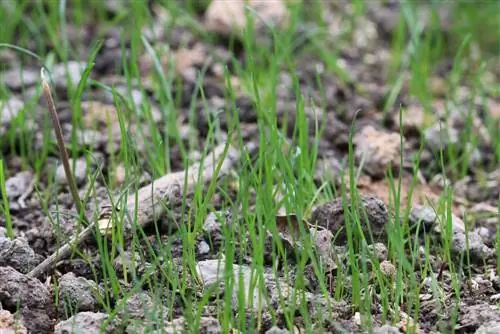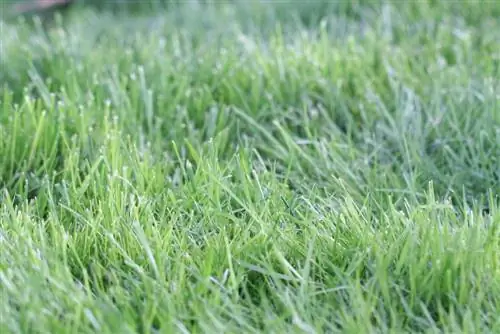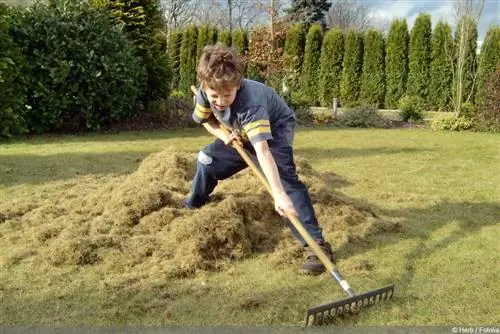- Author admin [email protected].
- Public 2023-12-17 03:39.
- Last modified 2025-01-24 12:45.
If your own lawn doesn't work as it should, the only solution is usually to completely replant the old lawn. Although this requires some effort, it is still worth it. In any case, the procedure should be carefully planned at the beginning, this is the only way to rule out mishaps to some extent.
Lawn mixtures
In Germany there are DIN standards for lawn mixtures. These are named separately for each purpose - for ornamental, carpet, play or shade lawns.
If you want to sow your lawn yourself, you have the option of having a mixture put together according to your individual wishes. However, only a few specialist retailers are willing to make this effort, which is only worthwhile if larger areas are required. To green a small garden, you are usually best served with commercially available mixtures.
Seedbed preparation
- Clumps of earth are broken with a roller or by tamping evenly over the entire area. Then collect stones and roots-
- When the seedbed is smooth and level, roll again, twice in opposite directions.
- Consolidate the soil again 1 week later. Then it is done in a crisscross manner and the process is repeated.
- Finally, work in about 1 handful of universal lawn fertilizer per square meter with the rake. Before sowing or laying, the soil must rest for about a week.
Sowing grass
Pluck out germinated wild herbs, then break off lumps and stones. Then the area must be leveled. When sowing by hand, seed strips are staked out with strings. Spread a precisely calculated amount of seed in two opposite courses.
Initial care measures
The approximately 4 cm high grass pile is carefully swept away without scratching the sensitive seedbed. Snails are collected. Freshly emerged lawn is lightly rolled, for example with the roller of a cylinder mower with the blades raised. Mow carefully for the first time about 6 months after sowing.
finished lawn
Ready-made grass sods with already sprouted greens are available from specialist retailers. Make sure that the grass is uniformly well developed, free of wild herbs and that the proportion of fine-leaved varieties is high. The sods, which are reminiscent of carpet tiles, should all have the same thickness and the soil should have an even crumb structure so that no roots fall off. The cheapest and best-selling ready-made lawns contain a high proportion of high-quality varieties, so that a hard-wearing practical lawn is created. Mixed lawn is made up of a higher proportion of fine-leaved varieties and is relatively undemanding and easy to care for compared to sensitive park lawn.
Laying finished turf
- Lay the first row along one edge and press firmly.
- Place a board on the first row, move on to the next row.
- The board is placed on the second row and the third row is started, etc.
- The finished rolled turf is lightly rolled in a criss-cross pattern.
- Sweep away loose grass and roots with a broom.
- Finally, trim the edges with an edger or flat spade.
- Curves are cut using a sharp knife as the tip of a self-made compass. Do not carry out this fine work until you have finished laying.
Fertilization and top dressing
- To prevent the lawn from withering away in places or, at the other extreme, from burning, you should fertilize regularly. To do this, you grid the area with bamboo sticks or with stakes and string.
- Granular fertilizer can be easily applied with a spreader. You pull it across the lawn in parallel paths, whereby the overlap of the paths must not exceed the width of the wheels.
- A mixture of sifted clay soil, leaf compost, peat, garden compost and sharp-grain sand, which was prepared at least 1 year previously (half a bucket full per square meter), serves as top fertilizer.
Ventilation
- To aerate the lawn in early autumn, it is perforated evenly to a depth of 7.5 - 10 cm with a digging fork. This improves water drainage and loosens the soil.
- More efficient aeration is achieved with hollow tines that push the soil upwards. You sweep up the plugs and work sand into the holes with the rake.
- For larger areas, a lawn aerator is suitable, in which metal spikes are attached to a horizontal axis, which pierce the lawn when pushed.
Raking, rolling and sweeping
- The best way to clean the lawn before the first mowing in spring is with a leaf broom. It is also ideal for gently removing thatch from the turf in autumn.
- Unevenness caused by frost in winter can be smoothed out with a roller in spring, but in summer this would only make them worse.
- The lawn is cleaned of leaves and plant residues in autumn with the brush broom. This broom is also used to remove dirt and dew before mowing.
Instructions
Spring is the best time for sowing lawn seeds, but with ready-made lawns you can re-seed your lawn throughout the year. Before you can start building the new lawn, the old lawn must first be removed. To do this, it is advisable to dig the entire area deeply. The old turf can be dug under without major problems or, alternatively, removed. After the entire area has been dug up, the soil should be given a day of rest. The next day the entire area can be leveled with a rake. To do this, all thick lumps of earth are crushed and distributed evenly over the entire area. Depending on the type of soil, it is worth mixing in sand or lime. This ensures better drainage of the water and a better oxygen supply to the grass roots. If the soil has been severely affected, the bond should now have a few days to settle.
Once these initial preparations have been made, we can start sowing the lawn seeds or laying the finished lawn. This should be done conscientiously; only if the lawn is laid/sown perfectly will you be able to enjoy your new lawn for years to come. Once the lawn has grown, it's time to take care of it, because this is the only way the lawn will thrive in the long term. In addition to fertilizing the lawn in spring, watering it and mowing the lawn once a week - there is a lot to do. Anyone who slips up here will quickly notice this in the quality of their lawn.
The lawn should be given special care when you go on vacation. Many lawn owners make the mistake of cutting the lawn extremely short before going on vacation, but this actually has the opposite effect and can result in the lawn being burned by the sun. After returning from a two or three week vacation, it is better to cut the lawn several times to bring it back to the desired height. Lawn mowers that have a cutting height adjustment are very helpful in this context. This means you can mow your lawn individually and therefore maintain it optimally. In the winter months, it is advisable to put as little strain on the lawn as possible and to sweep away any flying leaves. The lawn is mowed until late autumn, and the lawnmower only gets its deserved break when growth has started.

